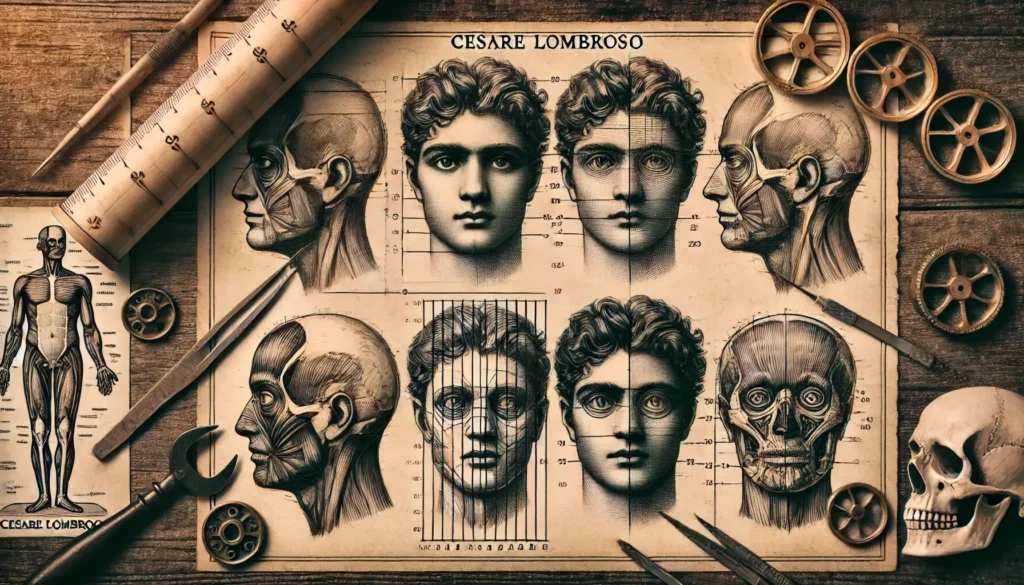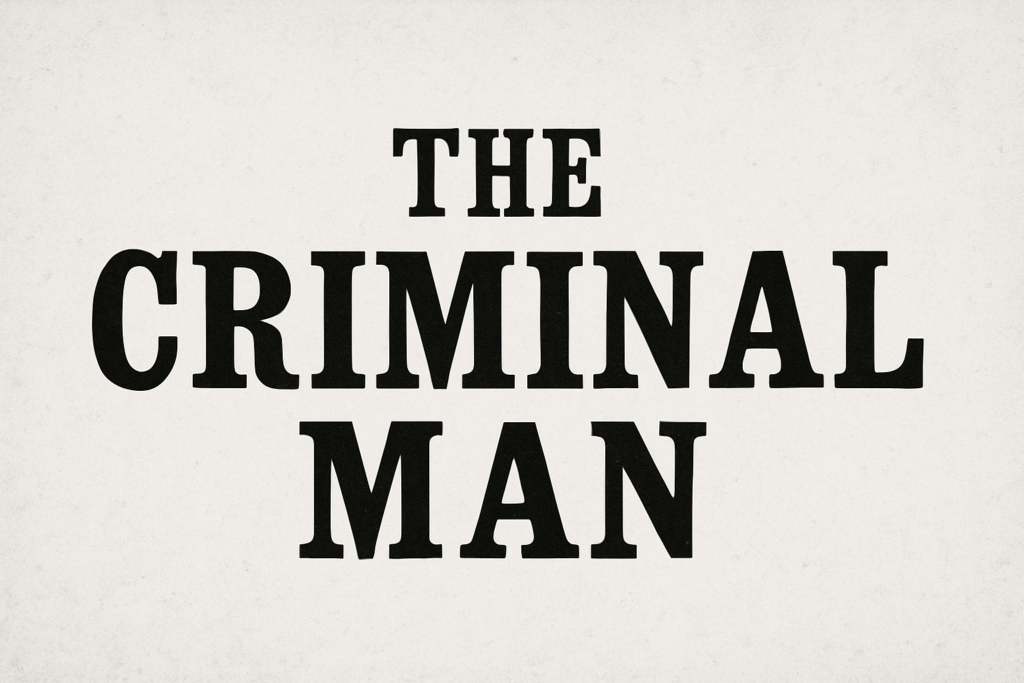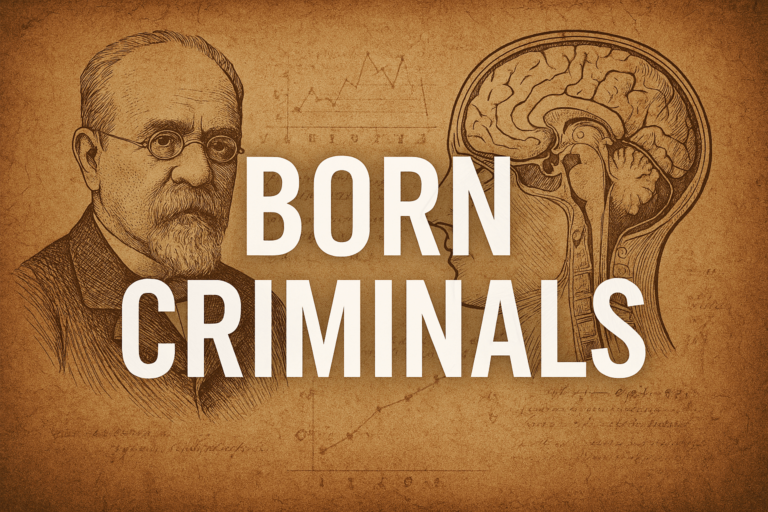The Criminal Man: A Revolutionary Study in Criminology (Cesare Lombroso)
Cesare Lombroso, often referred to as the father of modern criminology, introduced groundbreaking theories that transformed the understanding of criminal behavior. His seminal work, The Criminal Man (L’uomo Delinquente), published in 1876, marked a pivotal shift from classical criminology to a scientific approach based on biological determinism. Lombroso’s theory suggested that criminality is inherited and that criminals can be identified through physical anomalies, which he termed “atavistic stigmata.”
The Life and Work of Cesare Lombroso
Cesare Lombroso was born in Verona, Italy, in 1835. A physician and anthropologist, Lombroso’s interest in criminal behavior began during his time working in asylums and prisons, where he observed the physical characteristics of inmates. His medical background allowed him to approach criminology from a scientific perspective, applying empirical methods to study crime.
The Concept of The Criminal Man
In The Criminal Man, Lombroso proposed that criminals are born with innate traits that predispose them to criminal behavior. He identified these traits through extensive anthropometric measurements and comparative analysis between criminals and non-criminals. According to Lombroso, certain physical features, such as asymmetrical faces, large jaws, and pronounced brow ridges, were indicators of a “born criminal.”
Atavism and Biological Determinism
Lombroso’s theory of atavism suggested that criminals are evolutionary throwbacks to a more primitive stage of human development. This idea was influenced by Darwinian evolutionary theory, which was gaining prominence during Lombroso’s time. He believed that these “atavistic” traits manifested not only physically but also behaviorally, leading to impulsivity, lack of remorse, and a propensity for violence.

Classification of Criminals
Lombroso categorized criminals into different types:
- Born Criminals: Individuals with innate biological defects.
- Criminals by Passion: Those driven by strong emotions or moral outrage.
- Habitual Criminals: People who become criminals due to environmental factors and repeated offenses.
- Occasional Criminals: Individuals who commit crimes under specific circumstances.
Methodology and Research
Lombroso conducted autopsies and detailed examinations of prisoners, comparing them to “normal” individuals. His research included studying skull shapes, facial asymmetry, and other physical anomalies. Despite the extensive data collection, modern critiques highlight the lack of control groups and the subjective interpretation of results in Lombroso’s studies.
Impact on Criminology
Lombroso’s work laid the foundation for the positivist school of criminology, emphasizing scientific observation and empirical data. His theories influenced criminal profiling, forensic science, and even legal practices, shifting the focus from moral judgment to understanding the root causes of criminal behavior.
Criticism and Controversy
While Lombroso’s theories were revolutionary, they also faced significant criticism:
- Ethical Concerns: The deterministic view ignored social, psychological, and environmental factors.
- Scientific Validity: Modern genetics and psychology have debunked the notion of “born criminals.”
- Racism and Bias: Lombroso’s work has been criticized for reinforcing stereotypes and biases, particularly regarding race and class.

Legacy of The Criminal Man
Despite the controversies, Lombroso’s contribution to criminology is undeniable. He sparked debates that led to more comprehensive studies of criminal behavior, incorporating sociology, psychology, and environmental sciences. Today, criminology recognizes the complexity of criminal behavior, moving beyond biological determinism to a multifaceted approach.
Influence of Lombroso on the Positivist School
Lombroso’s work was instrumental in shaping the Positivist School of Criminology, which sought to understand crime through scientific methods. This school emphasized the study of measurable traits and observable behaviors to uncover the roots of deviance. Unlike classical theorists who focused on free will and moral responsibility, positivists like Lombroso aimed to identify patterns and predict criminal tendencies using empirical data.
This shift towards positivism led to the development of various tools in forensic science, including early attempts at criminal profiling and biometric analysis. Lombroso’s emphasis on objectivity and evidence-based research encouraged the establishment of criminology as a legitimate academic and scientific field.
Lombroso’s Influence on Criminal Profiling and Policing
One of the practical applications of Lombroso’s theories was in the early development of criminal profiling. By categorizing individuals based on physical traits and behavioral patterns, law enforcement began to create typologies of criminals. This rudimentary form of profiling, although flawed by modern standards, laid the groundwork for more advanced behavioral science approaches used today by agencies such as the FBI.
Additionally, Lombroso’s biological theories informed policing strategies that focused on surveillance and identification of “dangerous” individuals, especially in urban centers. His work influenced how suspects were evaluated, often prioritizing physical appearance as a marker of criminal potential.
Contributions to Prison Reform and Penal Policy
Lombroso’s classification of criminals also sparked discussions about the purpose of punishment. His work suggested that not all criminals were the same and, therefore, should not be treated equally by the justice system. This idea led to calls for more personalized sentencing and the consideration of rehabilitation for certain types of offenders, particularly “criminals by passion” and “occasional criminals.”
Prison reform advocates built on this notion by pushing for humane treatment, psychological assessments, and the establishment of correctional programs aimed at reintegration rather than mere punishment.
Comparative Analysis with Modern Biological Criminology
While Lombroso’s theories are now considered outdated, they share conceptual ground with contemporary studies in biosocial criminology. Modern research investigates the interaction between genetic predispositions, neurophysiological factors, and environmental influences. Rather than asserting a direct cause-effect relationship between biology and crime, today’s biological criminology explores how certain traits may increase susceptibility to deviant behavior when combined with adverse social conditions.
This integrative approach represents an evolution of Lombroso’s ideas, acknowledging complexity and rejecting deterministic interpretations.
Gender and Lombroso’s Theories
A lesser-known aspect of Lombroso’s work was his views on female criminality. In The Female Offender (1895), he argued that women were less evolved than men and therefore less prone to crime, except in cases where they exhibited “masculine” traits. These claims were based on biased interpretations of biological data and reflected the prevailing gender norms of the time.
Modern feminist criminology has heavily critiqued Lombroso’s portrayal of women, emphasizing the need to understand female criminal behavior through the lens of social inequality, power structures, and gender-specific experiences.
Global Impact and Legacy in Criminal Anthropology
Lombroso’s influence extended far beyond Italy. His theories were adopted, debated, and reinterpreted in countries across Europe and the Americas. In Latin America, for instance, criminologists and legal scholars embraced his ideas as part of a broader push to modernize penal systems.
Although many of his assumptions have been debunked, Lombroso is still recognized as a pioneer in criminal anthropology. His methodology, which involved observation, data collection, and theory-building, helped lay the groundwork for future scientific inquiries into human behavior.

Conclusion
The Criminal Man remains a landmark in the history of criminology. Cesare Lombroso’s attempt to apply scientific methods to the study of crime marked the beginning of criminology as an academic discipline. While his theories are outdated, they paved the way for modern criminological research, emphasizing the importance of empirical evidence and the need to understand crime from multiple perspectives.






